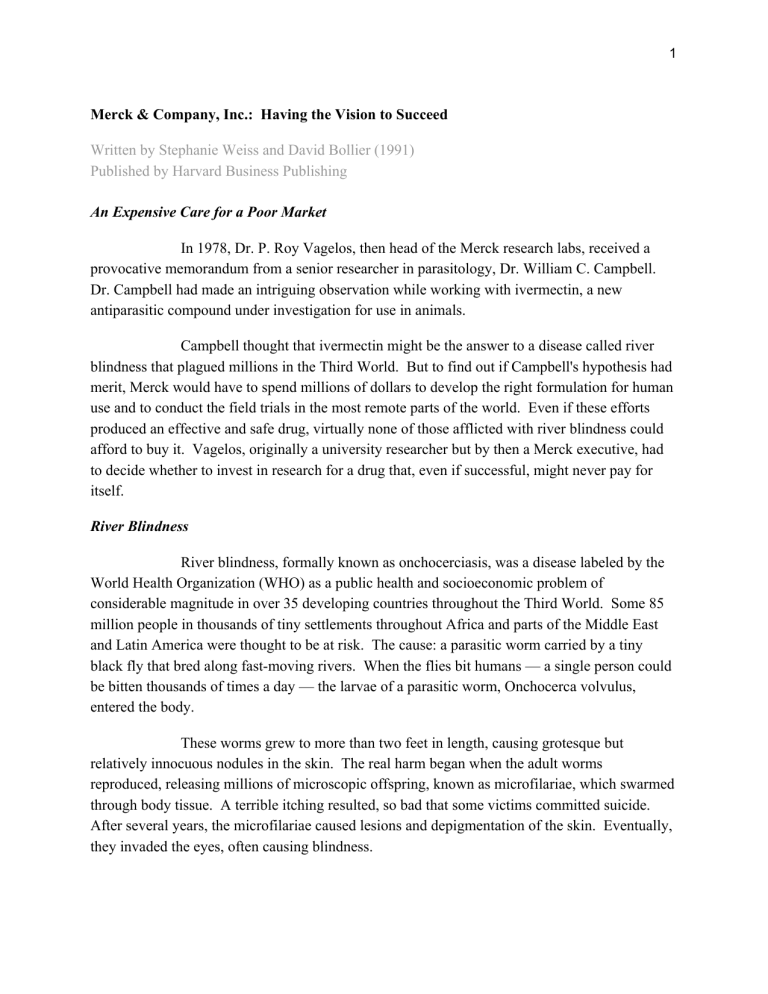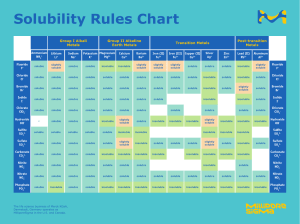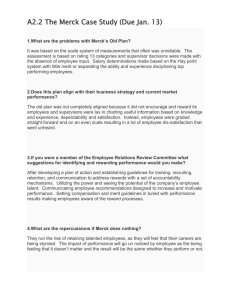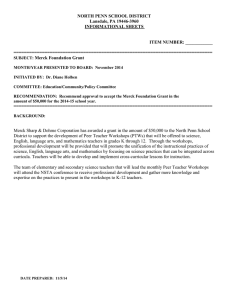
1 Merck & Company, Inc.: Having the Vision to Succeed Written by Stephanie Weiss and David Bollier (1991) Published by Harvard Business Publishing An Expensive Care for a Poor Market In 1978, Dr. P. Roy Vagelos, then head of the Merck research labs, received a provocative memorandum from a senior researcher in parasitology, Dr. William C. Campbell. Dr. Campbell had made an intriguing observation while working with ivermectin, a new antiparasitic compound under investigation for use in animals. Campbell thought that ivermectin might be the answer to a disease called river blindness that plagued millions in the Third World. But to find out if Campbell's hypothesis had merit, Merck would have to spend millions of dollars to develop the right formulation for human use and to conduct the field trials in the most remote parts of the world. Even if these efforts produced an effective and safe drug, virtually none of those afflicted with river blindness could afford to buy it. Vagelos, originally a university researcher but by then a Merck executive, had to decide whether to invest in research for a drug that, even if successful, might never pay for itself. River Blindness River blindness, formally known as onchocerciasis, was a disease labeled by the World Health Organization (WHO) as a public health and socioeconomic problem of considerable magnitude in over 35 developing countries throughout the Third World. Some 85 million people in thousands of tiny settlements throughout Africa and parts of the Middle East and Latin America were thought to be at risk. The cause: a parasitic worm carried by a tiny black fly that bred along fast-moving rivers. When the flies bit humans — a single person could be bitten thousands of times a day — the larvae of a parasitic worm, Onchocerca volvulus, entered the body. These worms grew to more than two feet in length, causing grotesque but relatively innocuous nodules in the skin. The real harm began when the adult worms reproduced, releasing millions of microscopic offspring, known as microfilariae, which swarmed through body tissue. A terrible itching resulted, so bad that some victims committed suicide. After several years, the microfilariae caused lesions and depigmentation of the skin. Eventually, they invaded the eyes, often causing blindness. 2 The World Health Organization estimated in 1978 that some 340,000 people were blind because of onchocerciasis and that a million more suffered from varying degrees of visual impairment. At that time, 18 million or more people were infected with the parasite, though half did not yet have serious symptoms. In some villages close to fly-breeding sites, nearly all residents were infected and a majority of those over age 45 were blind. In such places, it was said, children believed that severe itching, skin infections, and blindness were simply part of growing up. In desperate efforts to escape the flies, entire villages abandoned fertile areas near rivers and moved to poorer land. As a result, food shortages were frequent. Community life disintegrated as new burdens arose for already impoverished families. The disease was first identified in 1893 by scientists and in 1926 was found to be related to the black flies. But by the 1970s, there was still no cure that could safely be used for community-wide treatment. Two drugs, diethylcarbamazine (DEC) and Suramin, were useful in killing the parasite, but both had severe side effects in infected individuals, needed close monitoring, and had even caused deaths. In 1974, the Onchocerciasis Control Program was created to be administered by the World Health Organization, in the hope that the flies could be killed through spraying of larvicides at breeding sites, but success was slow and uncertain. The flies in many areas developed resistance to the treatment and were also known to disappear and then reinfest areas. Merck & Co., Inc.—A Summary of Operations Merck & Co., Inc. was, in 1978, one of the largest producers of prescription drugs in the world. Headquartered in Rahway, New Jersey, Merck traced its origins to Germany in 1668 when Friedrich Jacob Merck purchased an apothecary in the city of Darmstadt. Over three hundred years later, Merck, having become an American firm, employed over 28,000 people and had operations all over the world. In the late 1970s, Merck was coming off a 10-year drought in terms of new products. For nearly a decade, the company had relied on two prescription drugs for a significant percentage of its approximately $2 billion in annual sales: Indocin, a treatment for rheumatoid arthritis, and Aldomet, a treatment for high blood pressure. Henry W. Gadsden, Merck's chief executive from 1965 to 1976, along with his successor, John J. Horan, were concerned that the 17-year patent protection on Merck's two big money makers would soon expire, and began investing an enormous amount in research. Merck management spent a great deal of money on research because it knew that its success ten and twenty years in the future critically depended upon present investments. The 3 company deliberately fashioned a corporate culture to nurture the most creative, fruitful research. Merck scientists were among the best-paid in the industry and were given great latitude to pursue intriguing leads. Moreover, they were inspired to think of their work as a quest to alleviate human disease and suffering worldwide. Within certain proprietary constraints, researchers were encouraged to publish in academic journals and to share ideas with their scientific peers. Nearly a billion dollars was spent between 1975 and 1978, and the investment paid off. In that period, under the direction of the head of research. Dr. P. Roy Vagelos, Merck introduced Clinoril, a painkiller for arthritis; a general antibiotic called Mefoxin; a drug for glaucoma named Timoptic; and Ivomec (ivermectin, MSD), an antiparasitic for cattle. In 1978, Merck had sales of $1.98 billion and net income of $307 million. Sales had risen steadily between 1969 and 1978 from $691 million to almost $2 billion. Income during the same period rose from $106 million to over $300 million. At that time, Merck employed 28,700 people, up from 22,200 ten years earlier. Human and animal health products constituted 84% of the company's sales, with environmental health products and services representing an additional 14% of sales. Merck's foreign sales had grown more rapidly during the 1970s than had domestic sales, and in 1978 represented 47% of total sales. Much of the company's research operations were organized separately as the Merck Sharp & Dohme Research Laboratories, headed by Vagelos. Other Merck operations included the Merck Sharp & Dohme Division, the Merck Sharp & Dohme International Division, Kelco Division, Merck Chemical Manufacturing Division, Merck Animal Health Division, Calgon Corporation, Baltimore Aircoil Company, and Hubbard Farms. The company had 24 plants in the United States, including one in Puerto Rico, and 44 in other countries. Six research laboratories were located in the United States and four abroad. While Merck executives sometimes squirmed when they quoted the "unbusinesslike language" of George W. Merck, son of the company's founder and its former chairman, there could be no doubt that Merck employees found the words inspirational. "We try never to forget that medicine is for the people," Merck said. "It is not for profits. The profits follow, and if we have remembered that, they have never failed to appear. The better we have remembered it, the larger they have been." These words formed the basis of Merck's overall corporate philosophy. The Drug Investment Decision Merck invested hundreds of millions of dollars each year in research. Allocating those funds among various projects, however, was a rather involved and inexact process. At a 4 company as large as Merck, there was never a single method by which projects were approved or money distributed. Studies showed that, on average, it took 12 years and $200 million to bring a new drug to market. Thousands of scientists were continually working on new ideas and following new leads. Drug development was always a matter of trial and error; with each new iteration, scientists would close some doors and open others. When a Merck researcher came across an apparent breakthrough — either in an unexpected direction or as a derivative of the original lead — he or she would conduct preliminary research. If the idea proved promising, it was brought to the attention of the department heads. Every year, Merck's research division held a large review meeting at which all research programs were examined. Projects were coordinated and consolidated, established programs were reviewed and new possibilities were considered. Final approval on research was not made, however, until the head of research met later with a committee of scientific advisors. Each potential program was extensively reviewed, analyzed on the basis of the likelihood of success, the existing market, competition, potential safety problems, manufacturing feasibility, and patent status before the decision was made whether to allocate funds for continued experimentation. The Problem of Rare Diseases and Poor Customers Many potential drugs offered little chance of financial return. Some diseases were so rare that treatments developed could never be priced high enough to recoup the investment in research, while other diseases afflicted only the poor in rural and remote areas of the Third World. These victims had limited ability to pay even a small amount for drugs or treatment. In the United States, Congress sought to encourage drug companies to conduct research on rare diseases. In 1978, legislation had been proposed that would grant drug companies tax benefits and seven-year exclusive marketing rights if they would manufacture drugs for diseases afflicting fewer than 200,000 Americans. It was expected that this "orphan drug program" would eventually be passed into law. There was, however, no U.S. or international program that would create incentives for companies to develop drugs for diseases like river blindness, which afflicted millions of me poor in the Third World. The only hope was that some Third World government, foundation, or international aid organization might step in and partially fund the distribution of a drug that had already been developed. 5 The Discovery of Ivermectin The process of investigating promising drug compounds was always long, laborious and fraught with failure. For every pharmaceutical compound that became a "product candidate," thousands of others failed to meet the most rudimentary pre-clinical tests for safety and efficacy. With so much room for failure, it became especially important for drug companies to have sophisticated research managers who could identify the most productive research strategies. Merck had long been a pioneer in developing major new antibiotic compounds, beginning with penicillin and streptomycin in 1940. In the 1970s, Merck Sharp & Dohme Research Laboratories were continuing this tradition to help investigate new microbial agents of potential therapeutic value. Merck researchers obtained 54 soil samples from the Kitasato Institute of Japan in 1974. These samples seemed novel and the researchers hoped they might disclose some naturally occurring antibiotics. As Merck researchers methodically put the soil through hundreds of tests, Merck scientists were pleasantly surprised to detect strong antiparasitic activity in Sample No. OS3153, a scoop of soil dug up at a golf course near Ito, Japan. The Merck labs quickly brought together an interdisciplinary team to try to isolate a pure active ingredient from the microbial culture. The compound eventually isolated — avermectin — proved to have an astonishing potency and effectiveness against a wide range of parasites in cattle, swine, horses, and other animals. Within a year, the Merck team also began to suspect that a group of related compounds discovered in the same soil sample could be effective against many other intestinal worms, mites, ticks, and insects. After lexicological tests suggested that ivermectin would be safer than related compounds, Merck decided to develop the substance for the animal health market. In 1978, the first ivermectin-based animal drug, Ivomec, was nearing approval by the US Department of Agriculture and foreign regulatory bodies. Many variations would likely follow: drugs for sheep and pigs, horses, dogs, and others. Ivomec had the potential to become a major advance in animal health treatment. As clinical testing of ivermectin progressed in the late 1970s, Dr. William Campbell's ongoing research brought him face-to-face with an intriguing hypothesis. Ivermectin, when tested in horses, was effective against the microfilariae of an exotic fairly unimportant gastrointestinal parasite, Onchocerca cervicalis. This particular worm. while harmless in horses, had characteristics similar to the insidious human parasite that causes river blindness, Onchocerca volvulus. 6 Dr. Campbell wondered, could ivermectin be formulated to work against the human parasite? Could a safe, effective drug suitable for the community-wide treatment of river blindness be developed? Both Campbell and Vagelos knew that it was very much a gamble that it would succeed. Furthermore, both knew that even if success were attained, the economic viability of such a project would be nil. On the other hand, because such a significant amount of money had already been invested in the development of the animal drug, the cost of developing a human formulation would be much less than that for developing a new compound. It was also widely believed at this point that ivermectin, though still in its final development stages, was likely to be very successful. A decision to proceed would not be without risks. If a new derivative proved to have any adverse health effects when used on humans, its reputation as a veterinary drug could be tainted and sales negatively affected, no matter how irrelevant the experience with humans. In early tests, ivermectin had had some negative side effects on some specific species of mammals. Dr. Brian Duke of the Armed Forces Institute of Pathology in Washington, D.C. said the cross-species effectiveness of antiparasitic drugs are unpredictable, and there is "always a worry that some race or sub-section of the human population might be adversely affected." Isolated instances of harm to humans or improper use in Third World settings might also raise some unsettling questions: Could drug residues turn up in meat eaten by humans? Would any human version of ivermectin distribute to the Third World be diverted into the black market, undercutting sales of the veterinary drug? Could the drug harm certain animals in unknown ways? Despite these risks, Vagelos wondered what the impact might be of turning down Campbell's proposal. Merck had built a research team dedicated to alleviating human suffering. What would a refusal to pursue a possible treatment for river blindness do to morale? Ultimately, it was Dr. Vagelos who had to make the decision whether or not to fund research toward a treatment for river blindness.




